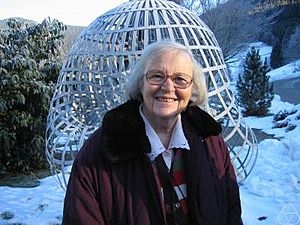Yvonne Choquet-Bruhat facts for kids
Quick facts for kids
Yvonne Choquet-Bruhat
|
|
|---|---|

Yvonne Choquet-Bruhat in 1974
|
|
| Born |
Yvonne Bruhat
29 December 1923 |
| Died | 11 February 2025 (aged 101) |
| Alma mater |
|
| Known for |
|
| Spouse(s) |
|
| Children | 3, including Daniel |
| Awards |
|
| Scientific career | |
| Fields | |
| Institutions | Pierre and Marie Curie University |
| Thesis | Théorème d'existence pour certains systèmes d'équations aux dérivées partielles non linéaires (1951) |
| Doctoral advisor | André Lichnerowicz |
Yvonne Choquet-Bruhat ( 29 December 1923 – 11 February 2025) was a French mathematician and physicist. She made seminal contributions to the study of general relativity, by showing that the Einstein field equations can be put into the form of an initial value problem which is well-posed. In 2015, her breakthrough paper was listed by the journal Classical and Quantum Gravity as one of thirteen 'milestone' results in the study of general relativity, across the hundred years in which it had been studied.
Choquet-Bruhat was the first woman to be elected to the French Academy of Sciences and was a Grand Officer of the Legion of Honour.
Early life
Yvonne Bruhat was born in Lille on 29 December 1923. Her mother was the philosophy professor Berthe Hubert and her father was the physicist Georges Bruhat, who died in 1945 in the concentration camp Oranienburg-Sachsenhausen. Her brother François Bruhat also became a mathematician, making notable contributions to the study of algebraic groups.
Bruhat undertook her secondary school education in Paris earning her Baccalauréat in 1941. She received the prestigious Concours Général national competition, winning the silver medal for physics. From 1943 to 1946 she studied at the École normale supérieure in Paris, and from 1946 was a teaching assistant there and undertook research advised by André Lichnerowicz.
Career
From 1949 to 1951 she was a research assistant at the French National Centre for Scientific Research, as a result of which she received her doctorate.
In 1951, she became a postdoctoral researcher at the Institute for Advanced Study in Princeton, New Jersey. Her supervisor, Jean Leray, suggested that she study the dynamics of the Einstein field equations. He also introduced her to Albert Einstein, whom she consulted with a few times further during her time at the institute.
In 1952, Bruhat and her husband were both offered jobs at Marseille, precipitating her early departure from the institute. In the same year, she published the local existence and uniqueness of solutions to the vacuum Einstein equations, her most renowned achievement. Her work proves the well-posedness of the Einstein equations, and started the study of dynamics in general relativity.
In 1958, she was awarded the CNRS Silver Medal. From 1958 to 1959 she taught at the University of Reims. In 1960 she became a professor at the Université Pierre-et-Marie-Curie (UPMC) in Paris, and remained professor or professor emeritus until her retirement in 1992.
At the Universite Pierre et Marie Curie she continued to make significant contributions to mathematical physics, notably in general relativity, supergravity, and the non-Abelian gauge theories of the standard model. Her work in 1981 with Demetrios Christodoulou showed the existence of global solutions of the Yang–Mills, Higgs, and spinor field equations in 3+1 Dimensions. Additionally in 1984 she made perhaps the first study by a mathematician of supergravity with results that can be extended to the currently important model in D=11 dimensions.
In 1978 Yvonne Choquet-Bruhat was elected a correspondent to the Academy of Sciences and on 14 May 1979 became the first woman to be elected a full member. From 1980 to 1983 she was President of the Comité international de relativité générale et gravitation ("International committee on general relativity and gravitation"). In 1985 she was elected to the American Academy of Arts and Sciences. In 1986 she was chosen to deliver the prestigious Noether Lecture by the Association for Women in Mathematics.
Technical research contributions
Choquet-Bruhat's best-known research deals with the mathematical nature of the initial data formulation of general relativity. A summary of results can be phrased purely in terms of standard differential geometric objects.
- An initial data set is a triplet (M, g, k) in which M is a three-dimensional smooth manifold, g is a smooth Riemannian metric on M, and k is a smooth (0,2)-tensor field on M.
- Given an initial data set (M, g, k), a development of (M, g, k) is a four-dimensional Lorentzian manifold (M, g) together with a smooth embedding f : M → M and a smooth unit normal vector field along f such that f *g = g and such that the second fundamental form of f, relative to the given normal vector field, is k.
In this sense, an initial data set can be viewed as the prescription of the submanifold geometry of an embedded spacelike hypersurface in a Lorentzian manifold.
- An initial data set (M, g, k) satisfies the vacuum constraint equations, or is said to be a vacuum initial data set, if the following two equations are satisfied:
-
- Here Rg denotes the scalar curvature of g.
One of Choquet-Bruhat's seminal 1952 results states the following:
Every vacuum initial data set (M, g, k) has a development f : M → (M, g) such that g has zero Ricci curvature, and such that every inextendible timelike curve in the Lorentzian manifold (M, g) intersects f(M) exactly once.
Briefly, this can be summarized as saying that (M, g) is a vacuum spacetime for which f(M) is a Cauchy surface. Such a development is called a globally hyperbolic vacuum development. Choquet-Bruhat also proved a uniqueness theorem:
Given any two globally hyperbolic vacuum developments f1 : M → (M1, g1) and f2 : M → (M2, g2) of the same vacuum initial data set, there is an open subset U1 of M1 containing f1(M) and an open subset U2 of M2 containing f1(M), together with an isometry i : (U1, g1) → (U2, g2) such that i(f1(p)) = f2(p) for all p in M.
In a slightly imprecise form, this says: given any embedded spacelike hypersurface M of a Ricci-flat Lorentzian manifold M, the geometry of M near M is fully determined by the submanifold geometry of M.
In an article written with Robert Geroch in 1969, Choquet-Bruhat fully clarified the nature of uniqueness. With a two-page argument in point-set topology using Zorn's lemma, they showed that Choquet-Bruhat's above existence and uniqueness theorems automatically imply a global uniqueness theorem:
Any vacuum initial data set (M, g, k) has a maximal globally hyperbolic vacuum development, meaning a globally hyperbolic vacuum development f : M → (M, g) such that, for any other globally hyperbolic vacuum development f1 : M → (M1, g1), there is an open subset U of M containing f(M) and an isometry i : M1 → U such that i(f1(p)) = f(p) for all p in M.
Any two maximal globally hyperbolic vacuum developments of the same vacuum initial data are isometric to one another.
It is now common to study such developments. For instance, the well-known theorem of Demetrios Christodoulou and Sergiu Klainerman on stability of Minkowski space asserts that if (ℝ3, g, k) is a vacuum initial data set with g and k sufficiently close to zero (in a certain precise form), then its maximal globally hyperbolic vacuum development is geodesically complete and geometrically close to Minkowski space.
Choquet-Bruhat's proof makes use of a clever choice of coordinates, the wave coordinates (which are the Lorentzian equivalent to the harmonic coordinates), in which the Einstein equations become a system of hyperbolic partial differential equations, for which well-posedness results can be applied.
Personal life and death
In 1947, she married fellow mathematician Léonce Fourès. Their daughter Michelle is (as of 2016) an ecologist. Her doctoral work and early research is under the name Yvonne Fourès-Bruhat. In 1960, Bruhat and Fourès divorced, she later married the mathematician Gustave Choquet and changed her last name to Choquet-Bruhat. She and Choquet had two children; her son, Daniel Choquet, is a neuroscientist and her daughter, Geneviève, is a doctor.
Choquet-Bruhat died on 11 February 2025, at the age of 101.
Awards
- Médaille d'Argent du Centre National de la Recherche Scientifique, 1958
- Prix Henri de Parville of the Académie des Sciences, 1963
- Member (since 1965), Comite International de Relativite Generale et Gravitation (President 1980–1983)
- Member, Académie des Sciences, Paris (elected 1979)
- Elected to the American Academy of Arts and Sciences 1985
- Association for Women in Mathematics Noether Lecturer, 1986
- Commandeur de la Légion d'honneur, 1997
- Dannie Heineman Prize for Mathematical Physics, 2003
- She was elevated to the 'Grand Officier' and 'Grand Croix' dignities in the Légion d'Honneur in 2008.
See also
 In Spanish: Yvonne Choquet-Bruhat para niños
In Spanish: Yvonne Choquet-Bruhat para niños




